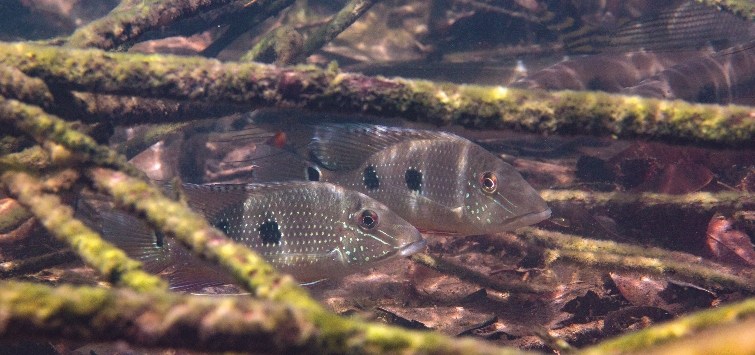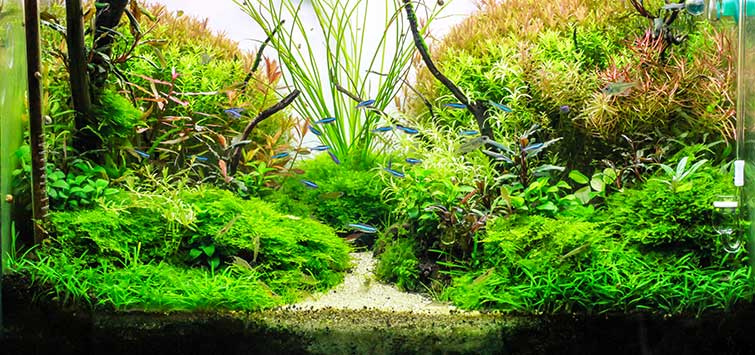Replicating Nature with Aquarium Lighting
Author: Oliver Lucanus
Nearly all of our aquarium fish come from forest streams and other small bodies of water. Others are found in lakes or larger rivers, often in rapids. One thing these natural habitats have in common is that they’re incredibly dynamic, changing over the course of the year. Water levels are in constant flux, and the distribution of the fish species may change with the habitat and availability of food, nesting sites, or changing depth. Light is never constant (unlike most aquarium lighting), but is rather in continuous motion due to waves, depth, structures, sun angle, and the forest canopy.
The play of natural sunlight on and through water lends a nearly magical aura to natural waterways, creating a feeling of wonder that is largely why so many of us got fascinated by fish in the first place. If you are a fishkeeper who has never observed fish in nature, make it a priority to do so, and you will quickly understand why, in the wild, light under water is so sublime and fascinating.
In our aquariums, light tends to be incredibly constant. A timer turns on the light, and an even illumination spreads across the entire habitat for many hours. Anyone who has snorkeled on a reef or a freshwater river or lake knows that natural light under water is variable and ever-changing. But in the aquarium, we largely ignore this factor.
To incorporate a more dynamic aquarium lighting scheme, some simple tricks can be used that will shape the light to make your tank’s ambiance more natural. Let us look at some of the factors that affect light in natural bodies of water, and how they can be recreated in the aquarium.
Waves, Rapids, and Currents
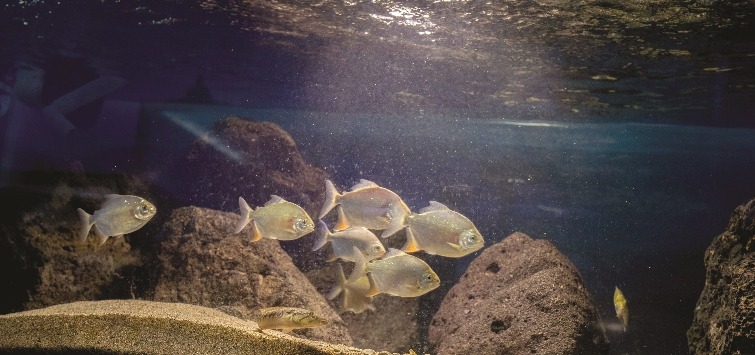
One of the greatest differences between the aquarium and any natural habitat is the surface movement of the water. Waves are spectacular in nature, and certainly beautiful to incorporate in an aquarium setup, but at the same time absolutely impractical for a typical home aquarium. Waves generated in the aquarium can lead to splashes and spills, break glass panels, or could even rock an aquarium off its stand.
An active surface with a lot of movement is a better choice here. This effect can be easily achieved with a pump or powerhead aimed at a slight angle toward the surface. The greater that surface movement, the more interesting the display of light playing on the tank’s structure and substrate, as rays of light are constantly changing their angle over the bottom. As a bonus, an active surface will improve aquarium oxygenation, which promotes good health in both your fishes and the tank’s biological filtration.
Forest Canopy
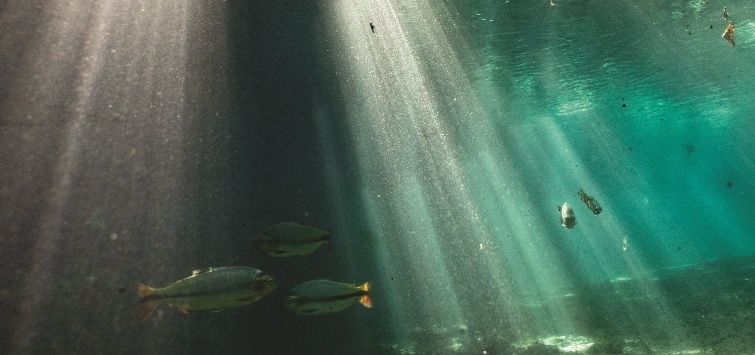
In nature, many aquatic habitats are covered by a forest canopy. Sunlight rarely penetrates the water evenly there, creating a patchwork of light and shadow. In many places from which our fishes are collected, sunlight penetrates the habitat only for short periods of time, at ever-changing angles. This uneven light is used by predators and prey alike for both ambush and escape.
In the aquarium, this forest-canopy effect is rarely recreated. Our standard lights are usually the same length as the aquarium, causing a uniformly lit bottom.
To get away from this “office lighting” effect and create a more natural aquarium atmosphere, use shorter lights and leave a darker area on one side of the tank, or overlap short lights to create areas with more intense brightness. Strips of black plastic (make sure to use non-flammable materials!) can be placed to darken parts of a light fixture.
Alternatively, houseplants such as Ficus, pothos, or even tomato or basil plants can be used to create a more uneven light pattern. Simply raise the light fixture about 8 to 12 inches (20 to 30 cm) above the aquarium, suspending it or using a simple wood frame to raise it, and place plants around the edges.
Many types of vining plants, such as pothos (Epipremnum aureum), will thrive with their roots in the water and the rest of the plant hanging down the side. The roots will add to the natural effect in the water and also remove surplus nutrients. The more intricate this patchwork of shadows, the most interesting the light effect on the fishes and the aquarium. LEDs are often more directional than the more diffused light of fluorescent bulbs, and therefore are more easily and effectively used to create this visual atmosphere.
Structure
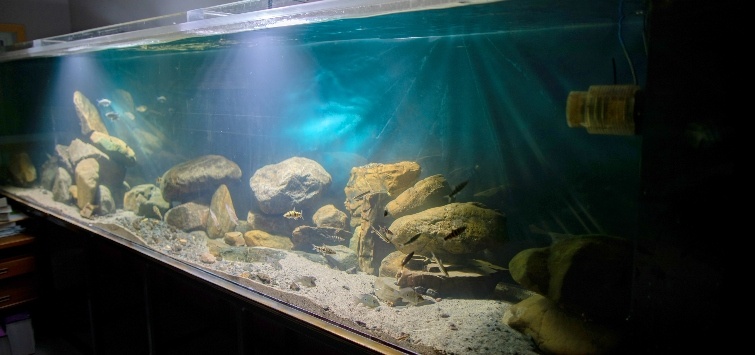
Nature has little regard for our sense of order. The assembly of rocks and driftwood in our aquariums, carefully selected and meticulously placed to look natural in just the right way, may be found in a wild habitat, but their positioning there is far more chaotic.
Driftwood, fallen trees, branches and palm fronds often get pushed into a wild tangle by the currents, producing ideal sites for smaller fishes to gather. Hardwood branches—fallen and aged maple, oak, etc.—can create these types of habitats in the aquarium, combined with driftwood to achieve a more natural look.
And don’t be afraid of the dark! You can create deep shadows by lifting a boulder off the substrate and making an area totally devoid of light. Such heavy structures should be placed on the ground for practice beforehand, to test their stability. They should then be built in the aquarium before any sand or gravel is added, to avoid too much pressure being concentrated in one place.
Many fish, even open-water swimmers such as small tetras or barbs, like to live along the edge of these deep shadows, ready to move from one light extreme to the other to avoid predators. Predatory fish also prefer a large overhanging structure from where they can view passing schools of fish and ambush potential prey. A well-anchored boulder can create this look, drawing out normally shy fishes to spend some time
Aquarium Lighting Types
Natural white lamps at higher Kelvin temperatures often give a more natural look than the warmer lights, unless you are recreating a blackwater habitat. Quality matters here, and when tested, HO T5 aquarium bulbs produced much better results than hardware store bulbs.
A similar result was found with LEDs: the single-celled (actually, tight-cell-clustered) shop-light LEDs produce the most natural aquarium light effect of all lights tested. But they are not built for continuous operation, often lasting less than six months, likely due to the inefficient heat sinks on their relatively small profiles. 6500K aquarium LEDs with multiple cells produced very good results, and they last for years. So in the case of lights, there is limited value to the inexpensive choices.
Modern aquarium equipment can do many things that required some tinkering in the past. New LED lights can now be precisely controlled, allowing for sunrise and sunset simulations as well as accurate control of the color temperature. Since more and more of us have an interest in simulating our fishes’ natural environments, making the aquarium lighting more natural is an obvious step to take. Even fishes from bright lake environments like Lakes Malawi or Tanganyika will look more natural with movement at the surface and less homogeneous illumination.
Creating a More Natural Aquarium Atmosphere
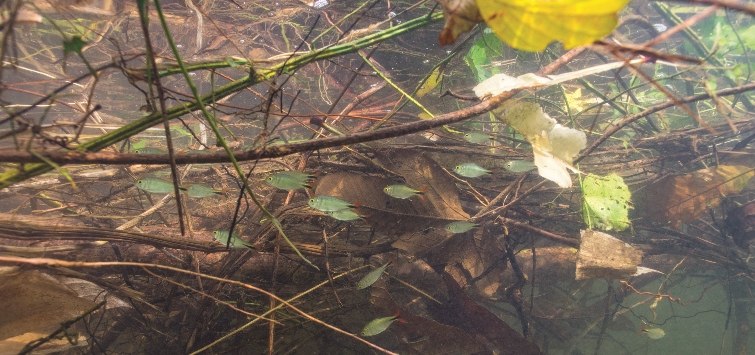
Lighting, water movement, and the choice of aquascaping materials are the three key elements to achieve a more natural look in the aquarium. Since the age-old community aquarium is making a miraculous comeback in the hobby, we should make it a fish community with conditions and décor that depict their habitat as accurately as possible.

.png?h=595&iar=0&w=2781&hash=5FD5E69473BCC22199FBFA2FB71B6033)
